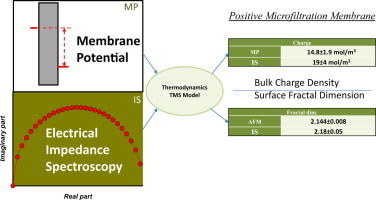当前位置:
X-MOL 学术
›
Chem. Eng. Sci.
›
论文详情
Our official English website, www.x-mol.net, welcomes your
feedback! (Note: you will need to create a separate account there.)
Impedance Spectroscopy and Membrane Potential Analysis of Microfiltration Membranes. The Influence of Surface Fractality
Chemical Engineering Science ( IF 4.1 ) Pub Date : 2018-03-01 , DOI: 10.1016/j.ces.2017.12.027 Darío Ramón Díaz , Francisco Javier Carmona , Laura Palacio , Nelio Ariel Ochoa , Antonio Hernández , Pedro Prádanos
Chemical Engineering Science ( IF 4.1 ) Pub Date : 2018-03-01 , DOI: 10.1016/j.ces.2017.12.027 Darío Ramón Díaz , Francisco Javier Carmona , Laura Palacio , Nelio Ariel Ochoa , Antonio Hernández , Pedro Prádanos

|
Abstract In this work, the proper charge density of a microfiltration membrane has been determined by using two different methods. Firstly, the ionic transport of a KCl solution has been investigated by simultaneous measurements of saline flux and membrane potential (MP) resulting from a concentration gradient through the membrane. A simple model, including all the relevant contributions to the global electrical potential drop, allowed a calculation of transport numbers and membrane charge density. The response of ions inside the membrane to an oscillating electrical potential has been analyzed by impedance spectroscopy (or electrical impedance spectroscopy EIS). A quite simple experimental EIS design allowed, by taking into account MP measurements too, an easy assignation of an equivalent circuit. After a careful analysis of EIS results, it was possible to evaluate the electrical conductivity inside the pores and the charge density. Both were found to be quite similar to the values obtained from MP alone. This agreement of EIS results with the MP ones, that are much simpler to deal with, confirms the accuracy of EIS to study the electrical properties of microfiltration membranes. The influence of electrode roughness and, in our EIS cell, the membrane roughness, on the constant phase element (CPE) of the equivalent circuit has been proved. Within this frame, the roughness fractal dimension of the membrane surface could be determined from EIS measurements. It resulted in fair agreement with the atomic force microscopy (AFM) determination.
中文翻译:

微滤膜的阻抗谱和膜电位分析。表面分形的影响
摘要 在这项工作中,使用两种不同的方法确定了微滤膜的适当电荷密度。首先,通过同时测量盐水通量和膜电位 (MP) 来研究 KCl 溶液的离子传输,该膜电位 (MP) 是通过膜的浓度梯度产生的。一个简单的模型,包括对全局电势降的所有相关贡献,允许计算传输数和膜电荷密度。膜内的离子对振荡电势的响应已通过阻抗谱(或电阻抗谱 EIS)进行分析。一个非常简单的实验性 EIS 设计允许,通过考虑 MP 测量,一个等效电路的简单分配。在仔细分析 EIS 结果后,可以评估孔内的电导率和电荷密度。发现两者都与单独从 MP 获得的值非常相似。EIS 结果与 MP 结果的这种一致性,更容易处理,证实了 EIS 研究微滤膜电特性的准确性。已经证明了电极粗糙度和我们的 EIS 电池中的膜粗糙度对等效电路的恒定相位元件 (CPE) 的影响。在这个框架内,膜表面的粗糙度分形维数可以从 EIS 测量中确定。它与原子力显微镜 (AFM) 测定结果一致。发现两者都与单独从 MP 获得的值非常相似。EIS 结果与 MP 结果的这种一致性,更容易处理,证实了 EIS 研究微滤膜电特性的准确性。已经证明了电极粗糙度和我们的 EIS 电池中的膜粗糙度对等效电路的恒定相位元件 (CPE) 的影响。在这个框架内,膜表面的粗糙度分形维数可以从 EIS 测量中确定。它与原子力显微镜 (AFM) 测定结果一致。发现两者都与单独从 MP 获得的值非常相似。EIS 结果与 MP 结果的这种一致性,更容易处理,证实了 EIS 研究微滤膜电特性的准确性。已经证明了电极粗糙度和我们的 EIS 电池中的膜粗糙度对等效电路的恒定相位元件 (CPE) 的影响。在这个框架内,膜表面的粗糙度分形维数可以从 EIS 测量中确定。它与原子力显微镜 (AFM) 测定结果一致。在我们的 EIS 电池中,等效电路的恒定相位元件 (CPE) 上的膜粗糙度已得到证明。在这个框架内,膜表面的粗糙度分形维数可以从 EIS 测量中确定。它与原子力显微镜 (AFM) 测定结果一致。在我们的 EIS 电池中,等效电路的恒定相位元件 (CPE) 上的膜粗糙度已被证明。在这个框架内,膜表面的粗糙度分形维数可以从 EIS 测量中确定。它与原子力显微镜 (AFM) 测定结果一致。
更新日期:2018-03-01
中文翻译:

微滤膜的阻抗谱和膜电位分析。表面分形的影响
摘要 在这项工作中,使用两种不同的方法确定了微滤膜的适当电荷密度。首先,通过同时测量盐水通量和膜电位 (MP) 来研究 KCl 溶液的离子传输,该膜电位 (MP) 是通过膜的浓度梯度产生的。一个简单的模型,包括对全局电势降的所有相关贡献,允许计算传输数和膜电荷密度。膜内的离子对振荡电势的响应已通过阻抗谱(或电阻抗谱 EIS)进行分析。一个非常简单的实验性 EIS 设计允许,通过考虑 MP 测量,一个等效电路的简单分配。在仔细分析 EIS 结果后,可以评估孔内的电导率和电荷密度。发现两者都与单独从 MP 获得的值非常相似。EIS 结果与 MP 结果的这种一致性,更容易处理,证实了 EIS 研究微滤膜电特性的准确性。已经证明了电极粗糙度和我们的 EIS 电池中的膜粗糙度对等效电路的恒定相位元件 (CPE) 的影响。在这个框架内,膜表面的粗糙度分形维数可以从 EIS 测量中确定。它与原子力显微镜 (AFM) 测定结果一致。发现两者都与单独从 MP 获得的值非常相似。EIS 结果与 MP 结果的这种一致性,更容易处理,证实了 EIS 研究微滤膜电特性的准确性。已经证明了电极粗糙度和我们的 EIS 电池中的膜粗糙度对等效电路的恒定相位元件 (CPE) 的影响。在这个框架内,膜表面的粗糙度分形维数可以从 EIS 测量中确定。它与原子力显微镜 (AFM) 测定结果一致。发现两者都与单独从 MP 获得的值非常相似。EIS 结果与 MP 结果的这种一致性,更容易处理,证实了 EIS 研究微滤膜电特性的准确性。已经证明了电极粗糙度和我们的 EIS 电池中的膜粗糙度对等效电路的恒定相位元件 (CPE) 的影响。在这个框架内,膜表面的粗糙度分形维数可以从 EIS 测量中确定。它与原子力显微镜 (AFM) 测定结果一致。在我们的 EIS 电池中,等效电路的恒定相位元件 (CPE) 上的膜粗糙度已得到证明。在这个框架内,膜表面的粗糙度分形维数可以从 EIS 测量中确定。它与原子力显微镜 (AFM) 测定结果一致。在我们的 EIS 电池中,等效电路的恒定相位元件 (CPE) 上的膜粗糙度已被证明。在这个框架内,膜表面的粗糙度分形维数可以从 EIS 测量中确定。它与原子力显微镜 (AFM) 测定结果一致。











































 京公网安备 11010802027423号
京公网安备 11010802027423号